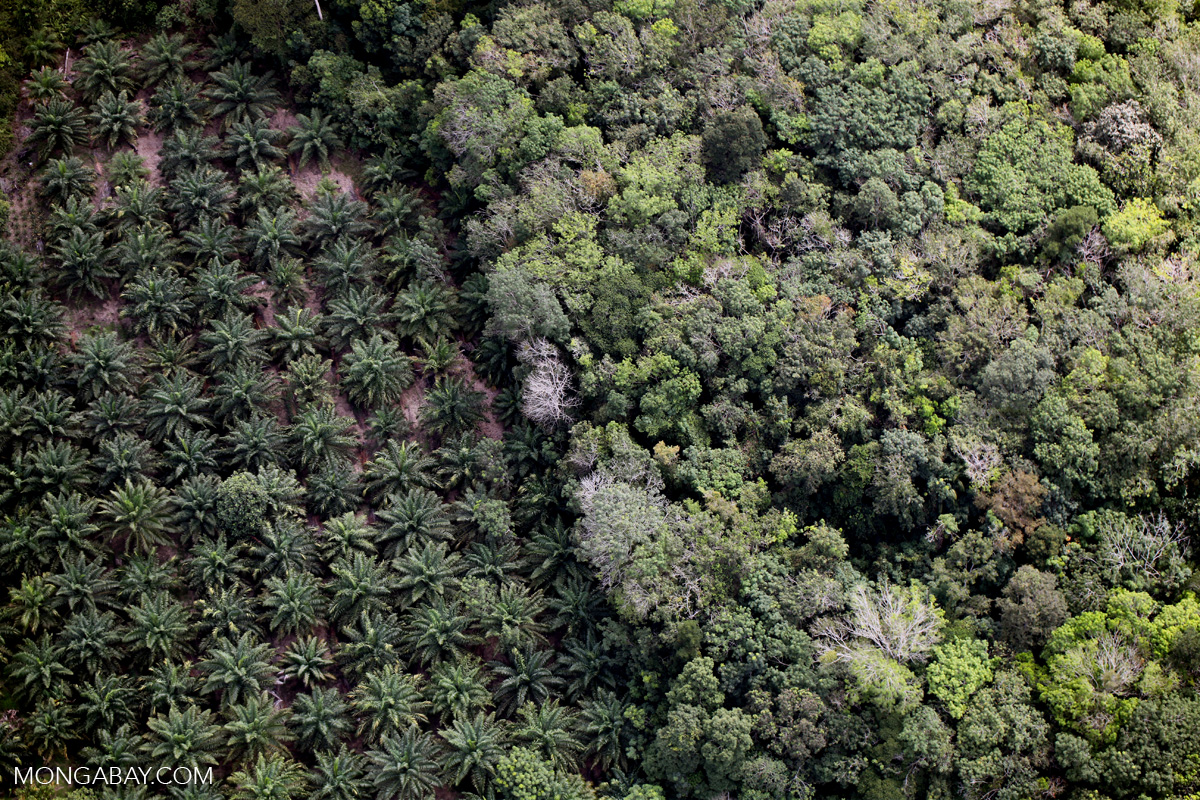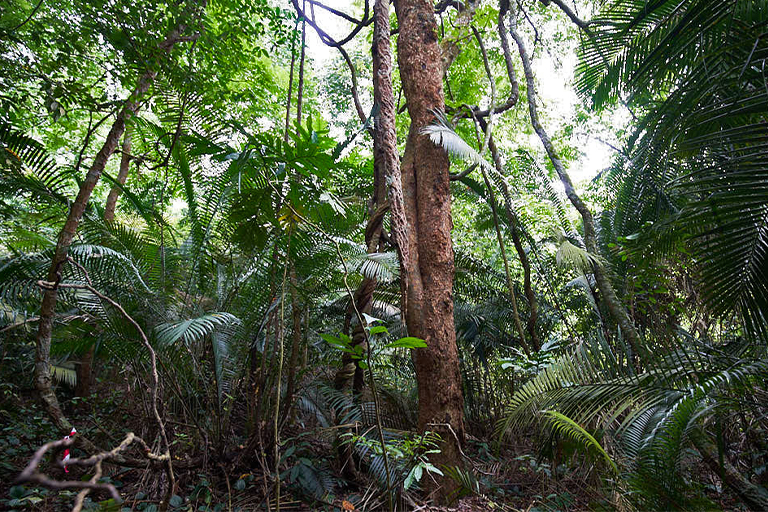[ad_1]
- In the seven years since Jemaluang and Tenggaroh were struck from Malaysia’s list of permanent forest reserves, the two forests in Johor state have experienced large-scale deforestation.
- The clearance is reportedly happening on land privately owned by the sultan of Johor, the head of the state, calling into question the effectiveness of the Central Forest Spine (CFS) Master Plan, a nationwide conservation initiative the two reserves had originally been part of.
- The CFS Master Plan is currently being revised, with experts seeing the review as a chance to change what has been a largely toothless program, beset by conflicts of interest between federal and state authorities.
- As the revision nears completion, Jemaluang and Tenggaroh highlight how much has been lost, but also what’s at stake for Malaysia’s forests, wildlife and residents.
Before the clearing and excavators and bulldozers, before plans to build a gold mine and oil palm plantations, the Jemaluang and Tenggaroh forest reserves in Johor, Malaysia, were wildlife-rich jungles by the sea.
Elephants, tigers and sun bears roamed the rainforests’ dimly lit interiors. Critically endangered tropical trees flourished by the seashore.
But in 2014, both reserves were struck from Johor’s list of permanent forest reserves, with parts of the land taken into private ownership. Seven years later, a fifth of the more than 17,000 excised hectares (42,000 acres) has been cleared, Malaysian environmental news site Macaranga reported.
Vast tracts of rainforest are being razed to the ground by extractive companies, which are reportedly profiting off timber sales while preparing to grow lucrative oil palm. All of this is happening on land owned by the sultan of Johor, the head of the state, according to Macaranga, which has raised questions about the effectiveness of a nationwide conservation initiative the two reserves had been part of.

A largely toothless plan
Before they were degazetted, the Jemaluang and Tenggaroh reserves had been part of the Central Forest Spine (CFS) Master Plan, a federal government-driven project aimed at forming an unbroken link of forests across Peninsular Malaysia.
First unveiled a decade ago, the CFS plan is now under review. An additional Improving Connectivity in the Central Forest Spine (IC-CFS) project, funded in part by the United Nations Development Programme and aimed at supporting its implementation, is also underway.
Officials say the updated program will focus on building conservation knowledge among state forestry departments, conserving biodiversity in priority forest areas, and setting up financing mechanisms such as payment-for-ecosystem services schemes.
Experts see the review as a chance to change what they say has been a largely toothless plan, beset by conflicts of interest between federal and state authorities — with Jemaluang and Tenggaroh being a case in point.
“[The federal government] never got any commitment from the states to implement the CFS plan,” Lim Teckwyn, a forest ecologist who helped conceptualize the original plan, told Mongabay. “The states always had their own ideas of going about things, and [based on the Constitution] they have the right.”

Forestry matters are state matters
Under Malaysia’s Constitution, it is the state, and not the federal government, that has constitutional right over forestry matters. The key decisionmaker is typically the menteri besar, or chief minister of each state, the degazetting process is “carried out secretly,” and the opposition isn’t consulted, let alone the public, Lim said.
In the case of Jemaluang and Tenggaroh, environmental impact assessment (EIA) reports indicate the roughly 4,000 hectares (9,900 acres) of forest cleared to date can be attributed to two extractive companies: AA Sawit, which is 51% owned by the Johor sultan, Ibrahim Ibni Almarhum Sultan Iskandar, and Nadi Mesra, a local company dealing mainly in property investments, timber logging and agricultural and mining activities.
There are at least three more projects proposing to convert another 24% of the forests into plantations and mines, according to Macaranga, which reports that two are headed by Nadi Mesra, helmed by Malaysian businessman Pek Kok Sam. The third is a gold mining joint venture between the Johor sultan and Southern Alliance, a Singapore-listed mining firm also run by Pek. Nadi Mesra and Southern Alliance did not respond to requests for comment, while AA Sawit declined to respond. The Johor royal press office and Johor state forestry department did not respond to requests for comment.

It’s not too late, there’s more at stake
As the CFS Master Plan’s review nears completion, conservationists say Jemaluang and Tenggaroh are undeniable proof of how much has been lost, but also what’s at stake for Malaysia’s forests, wildlife and residents.
Both former reserves host coastal dipterocarp forests, scarce in Peninsular Malaysia and rich in biodiversity. EIA reports record them harboring hundreds of plant and animal species, including endangered Asian elephants (Elephas maximus), Malayan tigers (Panthera tigris) and Sunda pangolins (Manis javanica).
Since the deforestation began, residents have reported increasing incidences of wildlife venturing into nearby villages and towns and clashing with humans. Elephants have been particularly destructive: residents say the animals have eaten oil palms, destroyed property, and otherwise caused hundreds of thousands of ringgit in losses in the past three years.
According to Lim, the CFS plan was conceived in part to mitigate human-wildlife conflict. But he added there’s still time to salvage the situation.
“It’s not too late for the elephants especially,” Lim said. “Elephants like grazing in open areas, and they’re happy in oil palm plantations if not for conflicts with plantation owners and workers. They love to eat oil palm saplings. If you stop clearing now and start connecting forests under the CFS plan then you won’t create bottlenecks that force elephants to come out of the forest and disturb people.”

Uniting all states under one conservation effort
The CFS revision comes as Malaysia steps up efforts to protect its forests after decades of deforestation and land degradation in the name of development. Under pressure from palm oil, agriculture, logging and other extractive industries, Malaysia has lost 29% of its tree cover in the last two decades, according to data from the University of Maryland visualized on Global Forest Watch.
Last year, the federal government announced it had budgeted 70 million ringgit ($16.8 million) for an ecological fiscal transfer (EFT) scheme that will see it paying states to conserve their forests. Earlier this year, the National Land Council (NLC), the highest governing body for land and forests in Malaysia and chaired by the prime minister, introduced a new Malaysian Forestry Policy (MFP) aimed at uniting all states under one conservation effort.
The first policy document on forest matters to cover Peninsular Malaysia and the Bornean states of Sabah and Sarawak (which previously all had their own distinct legislation), the MFP formally enshrines a promise made by the government in 1992 — often quoted but never written into national policies — to keep 50% of Malaysia’s land area under forest and tree cover.
At the launch of the policy in March, then-Prime Minister Muhyiddin Yassin highlighted the importance of preserving large and continuous areas of forest such as the CFS and Heart of Borneo in “[reducing] conflict between humans and wildlife [and enabling] the free movement of wildlife especially national iconic species which are facing extinction.”
But even as he spoke, deforestation, habitat loss and human-wildlife conflict were underway in Jemaluang and Tenggaroh, and other sections of the CFS across Malaysia.

‘It’s not about doing more, but doing this crucial step right’
Experts don’t foresee much changing unless the new plans are backed by specific legislation. The EFT mechanism, for one, is unlikely to be successful on its own: in 2019 alone, Johor, Kelantan, Pahang, Perak, Selangor, Terengganu and Kedah states each received between 20 million and more than 100 million ringgit ($4.8 million to $24 million) in forestry revenue, dwarfing the 70 million ringgit offered under the scheme.
And while the NLC’s policies take precedence over both federal and state government decisions, they neither impose time frames for execution, nor mention any penalties and incentives.
For the newly revised CFS plan to be effective, it should be anchored by the NLC, with corresponding legislation that spells out these details, a source involved in the review, who requested anonymity because the updated plan hasn’t been made public, told Mongabay.
“Right now, although the new plan encompasses a wide range of strategies, we will be back at the same spot as we were with the first plan if it is not instituted at a higher level,” the source said. “That is why a fraction of us within the revision team are now pushing to ensure the plan goes to a higher level, to the National Land Council, with legislation attached to it.
“This way, states must adhere to it even if they have prerogative over their land. It’s not about doing more, but doing this crucial step right,” the source said.

According to Lim, implementing a more transparent and democratic excision process will also be critical.
“If we could change the law, and put this power [to degazette] into the hands of the state legislative assembly, then the forests would not be controlled by a small group of people anymore. The assembly includes opposition parties so there would be checks and balances,” he said.
There is evidence that such checks and balances work to protect forests: last month, the Selangor government cancelled plans to clear a forest reserve after opposition from citizens and the legislative assembly. Unlike other states, Selangor mandates public hearings for any plan to degazette forest reserves, allowing for proposed excisions to be publicly scrutinized.
“Currently, a lot of community groups are mobilizing, and they’re getting stronger. We see them adopting the Western culture where if the state is wrong, they go to the courts to sue them,” the source involved in the review said.
In states where public hearings aren’t compulsory, having the CFS plan backed by the NLC and corresponding legislation would give these community groups “more legal instruments to make their case,” the source said.

‘People should still fight for it’
Malaysia’s forestry policy may be at a crossroads, but Jemaluang and Tenggaroh appear to still be largely unaffected by the broad forest protection goals sweeping across the country. Satellite data from the University of Maryland show deforestation continuing, with bursts of clearance occurring in June, August and September. Both forests also seem to have been removed entirely from the updated CFS plan; its recently launched website makes no mention of either.
In the meantime, Nadi Mesra has reportedly submitted a second EIA report proposing to turn another 2,000 hectares (4,900 acres) into a plantation and a gold mine. The company also has plans to submit a third report to convert an additional 2,200 hectares (5,400 acres), according to an investigation by Macaranga. The second report, reviewed by Mongabay, noted that this stretch of forest had originally been part of the wider Endau-Kota Tinggi wildlife reserve, but deemed its conversion a “non-issue” because, firstly, the land was now privately owned and, secondly, other projects in the area had also fragmented and degraded the reserves, which meant they “ceased to function as such effectively.”


But degradation shouldn’t be the sole consideration when deciding whether or not to clear a forest, said Ahmad Ismail, president of the Malaysian Nature Society. “Many factors need to be [taken into account] including erosion, aquatic ecosystems, coastal areas and weather,” he said. “Effects on local community livelihoods [are also] important to consider.”
When forests are cleared, he said, so are the trees that anchor soil and absorb water. After heavy tropical rains (which are common along the east coast during monsoon season), runoffs are more likely to carry sediment, fertilizer and pesticides into local rivers, affecting both aquatic life and the livelihoods of communities who rely on subsistence fishing and river water.
In the case of the gold mine, the extraction process could also negatively impact “human health and the environment, depending [on the] chemicals used,” Ahmad added. Mercury, a neurotoxin, is often used to separate gold ore from the surrounding substrate.
The anonymous source involved in the review said the revision team would be proposing alternative measures such as approaching land owners to contribute acreage for buffer zones and wildlife crossings. The source said this would help mitigate the negative consequences of deforestation activities in the short term and “preserve a space where linkage can still happen” in the long term.
“The future generations have stronger environmental awareness, so over time, as more people are aware of the CFS and its importance, [Jemaluang and Tenggaroh] could still be connected again,” the source said. “People think it’s lost and we can’t do anything anymore, but it’s not. People should still fight for it.”
Banner image of a Malayan tiger by Rhett A. Butler/Mongabay
Editor’s note: This story was powered by Places to Watch, a Global Forest Watch (GFW) initiative designed to quickly identify concerning forest loss around the world and catalyze further investigation of these areas. Places to Watch draws on a combination of near-real-time satellite data, automated algorithms and field intelligence to identify new areas on a monthly basis. In partnership with Mongabay, GFW is supporting data-driven journalism by providing data and maps generated by Places to Watch. Mongabay maintains complete editorial independence over the stories reported using this data.
FEEDBACK: Use this form to send a message to the author of this post. If you want to post a public comment, you can do that at the bottom of the page.
[ad_2]
阅读更多